“Bird migration is an extremely intricate series of movements, some of them incomprehensible, whose main characteristics are, as we have said before, their back and forth nature and their regularity, and their main purpose to find the most desirable living conditions for different times of the year.” ‒ Ali, Salim and Futehally, Laeeq in Common Birds, 1967.
More than 25% of the birds of Delhi are migratory. As non-residents, they visit the city during specific times of the year, both to escape formerly unsuitable or unfruitful habitats, and to pursue a perceived opportunity for advancing ones survival.
According to a UNESCO report published in June 2013 entitled Social Inclusion of Internal Migrants in India, internal migrants comprise 43% of Delhi's total human population. The report goes on to further state that “the intensity of migration is expected to increase in the future as a response to economic crises, political instability, and global environment change...Migration is not always permanent, and seasonal and circular migration is widespread, especially among the socio-economically deprived groups such as SC, STs, and OBCs, who are asset poor and face resource and livelihood deficits.”
Delhi has been, and will continue to be a dense conglomerate of fluid, migrant populations, both bird and human. The aspirations of these two migrant species are similar: food security and growth opportunities for oneself and family. The migrant's challenges are also similar: eroding or hostile habitats and inconvenient nests. Like a metaphorical litmus test, the success or failure of these migrants will provide prophetic insight for the remaining resident population in the years to come.
“The bird population of Delhi is a large one, both in the aggregate and by species. I identified with reasonable certainty over 250 species, and on several occasions met more than 100 of these in a single day. About half the species seen were resident in the area, and rather more than a quarter of the remainder either visitors or on a passage.” – H.W. Hutson, 1945
In 2014 the World Health Organisation identified Delhi as having the most polluted air of any metropolis in the world. Increased vehicular and industrial emissions, agricultural burning within and in surrounding states, and higher intensity dust storms (to identify a select few); many factors have contributed to this atmospheric degradation. Delhi, the world's second-most bird-rich capital city after Nairobi, Kenya, is acutely suffering in the third dimension.
“As indigenous vegetation disappears or is reduced by constant and concentrated grazing to diminutive stature, one or other of which fates seems likely as the development of Delhi proceeds, so there will be changes in the bird population. Some species no doubt will be able to adapt themselves to the new conditions. They even find them advantageous. The wide ranging Parrakeets, for instance, which are quick to locate and raid a ripening crop may find the increasing cultivation beneficial. Many of the trees planted in Delhi gardens suit their tastes admirably as does the wheat which is being grown on former waste lands. For insect feeders, too, the development of the land may mean more food. But as gardens and crops replace the present waste land, Delhi will become a much more uniform bird habitat than it is today. The few small jheels, with permanent water which still remains, and the last reed-beds will almost certainly go as well as the indigenous woodlands. With this growing uniformity of habitat the present variety of bird life must diminish.” – H.W. Hutson, 1945
Delhi Birds is an urban portrait collection which spans from 2011 to 2014, featuring colour photographs taken 15,000 ft above sea level. Accompanying each image is a record of air pollution levels, as extrapolated from data published in 2011 by the Department of Environment, and as listed by the Central Pollution Control Board in 2013 and 2014.
Supplementing the visual archive are anecdotes and firsthand accounts of bird sightings in Delhi dating from the late 1800s to the late 1900s. Selected archival texts are isolated and juxtaposed in relation to individual photographs, as a means of weaving ornithological depth and metaphorical social commentary through various layers of visual form.
Badarpur Smog
February 2012
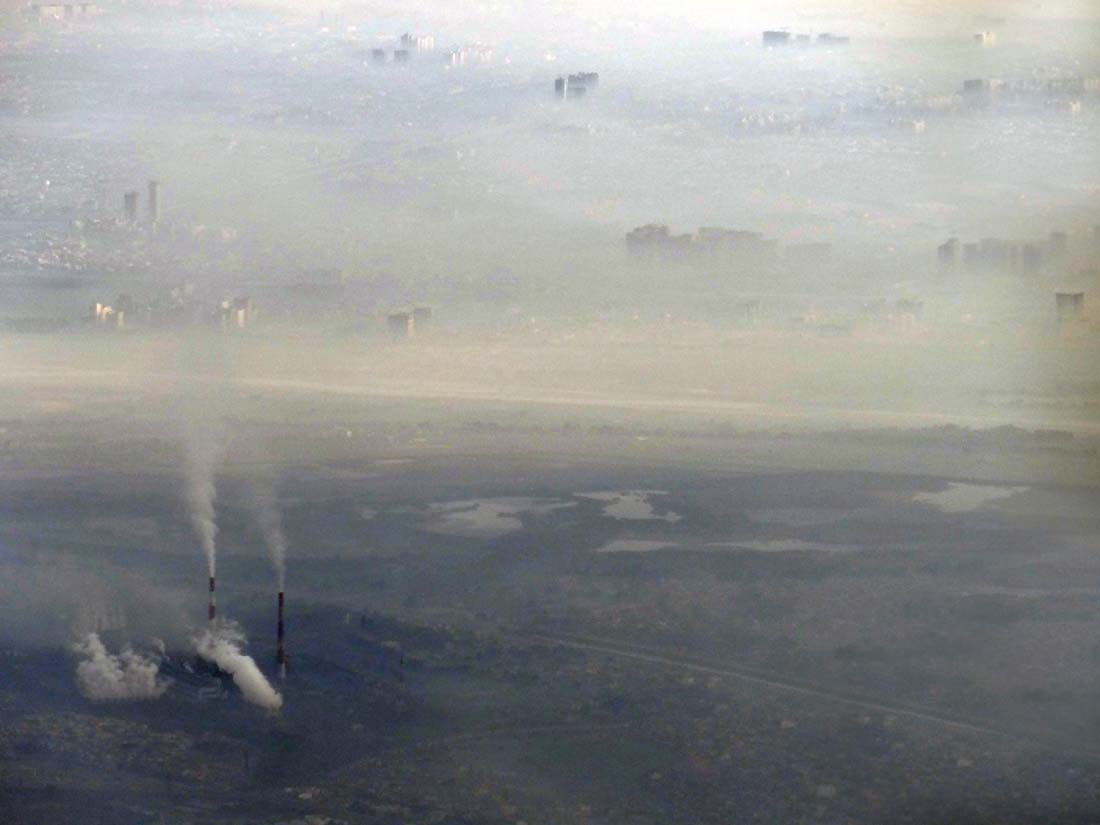
SO2 ‒ 30 ug / m3
NO2 ‒ 75 ug / m3
RSPM ‒ 275 ug / m3
Pied Crested Cuckoo
Calamator jacobinus
Migrant
“For days before the take-off for the long journey, the migrants are preparing for it. They eat greedily to put on an extra layer of fat which will sustain them during the trip; some even practice forming and flying in flocks or 'balling up' as it is called. Experiments suggest that it is the timing of the rising and setting sun which gives migrants their final cue for departure. Fogs and mists which obscure the sun can throw the birds off their course for a while although with the return of visibility they are able to realign themselves fairly well.” ‒ Common Birds, Page 18, Ali, Salim and Futehally, Laeeq, 1967.
Yamuna Sangam
February 2012
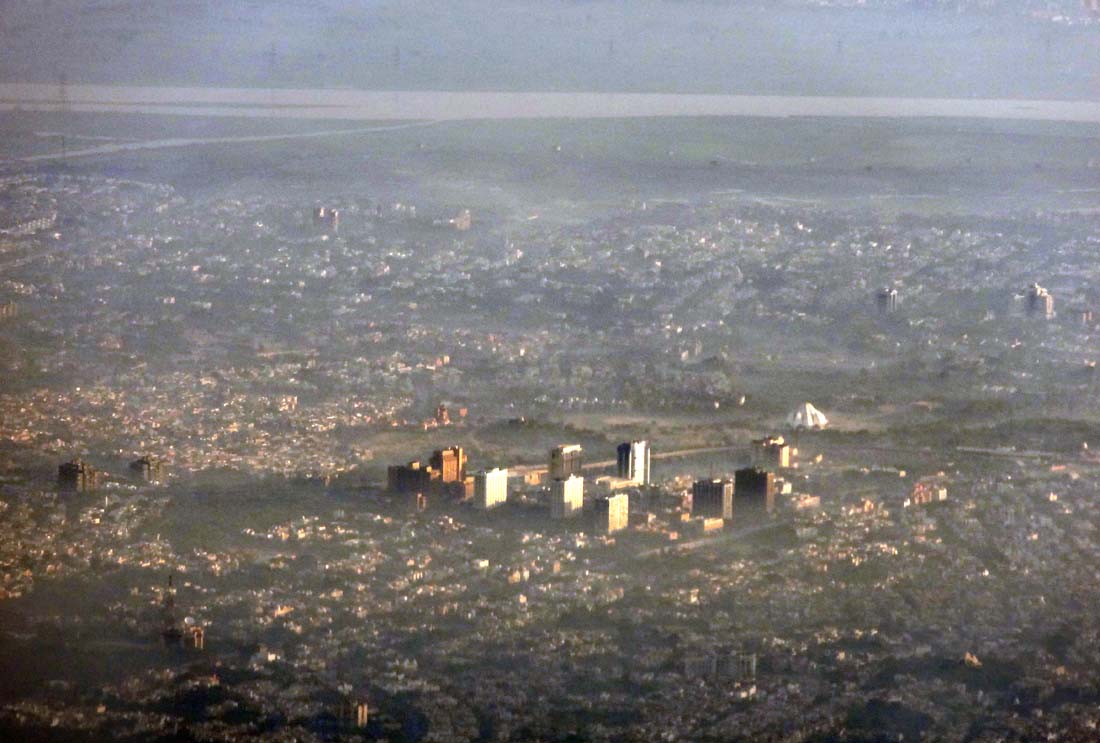
SO2 ‒ 30 ug / m3
NO2 ‒ 75 ug / m3
RSPM ‒ 275 ug / m3
Red munia
Estrilda amandava
Resident
“The most significant of waterbodies is of course the Yamuna. Despite a very high pollution level, the river still attracts large numbers of waterfowl. Thousands of migratory ducks congregate in winter near the Wazirabad Bridge, the Okhla Barrage, and some other spots along the Yamuna. In addition the low-lying flood plains on both sides are marshy for a part of the year, attracting a large diversity of waders and other birds. The vegetation along the river's banks has its own distinct birdlife, Red munias & weaver birds adding brilliant flashes of colour.” ‒ What's that bird? A guide to birdwatching, with special reference to Delhi, Page 54, Kalpavriksh, 1991.
Ring Road
February 2012

SO2 ‒ 30 ug / m3
NO2 ‒ 75 ug / m3
RSPM ‒ 275 ug / m3
Roseringed parakeet
Psittacula krameri
Resident
“Among the features of Delhi bird-life are its large scale gregarious roosts centered to a great extent on the city itself. Kites, Crows, Parrakeets and Common Mynahs all come into large roosts every evening and fly out the following morning. Most of these birds, which roost in the trees and shrubberies of the Delhi gardens, feed outside the built-up area. The daily fly-out from the roost is a most regular affair by suntime and only when the sky is very overcast is the schedule likely to be delayed. On the return flight I thought that the Crows coming Delhi followed the tree-lined roads in preference to cutting across the open country. Flocks would fly to a road and then turn along it. The fast flying Parrakeets did not adopt the practice, nor did the Mynahs.” ‒ The Birds About Delhi, Page XXX - XXXI, The Delhi Bird Watching Society, 1954.
Migrant Populations
December 2011

SO2 ‒ 25 ug / m3
NOx ‒ 65 ug / m3
RSPM ‒ 265 ug / m3
Spoonbill
Platalea leucorodia
Resident + Migrant
“The question which first comes to mind is, why do some species of birds migrate and not others? The obvious answer is that migration has a survival value for some species and not for others. In some species the survival value must be marginal because some of their members stay at home while others migrate. Examples of the undecided species are our coots and spoonbils. A part of their population migrates every year, while others remain within the country without suffering any apparent disadvantage.” ‒ Common Birds, Page 16, Ali, Salim and Futehally, Laeeq, 1967.
Tughlaqabad Fort
February 2012
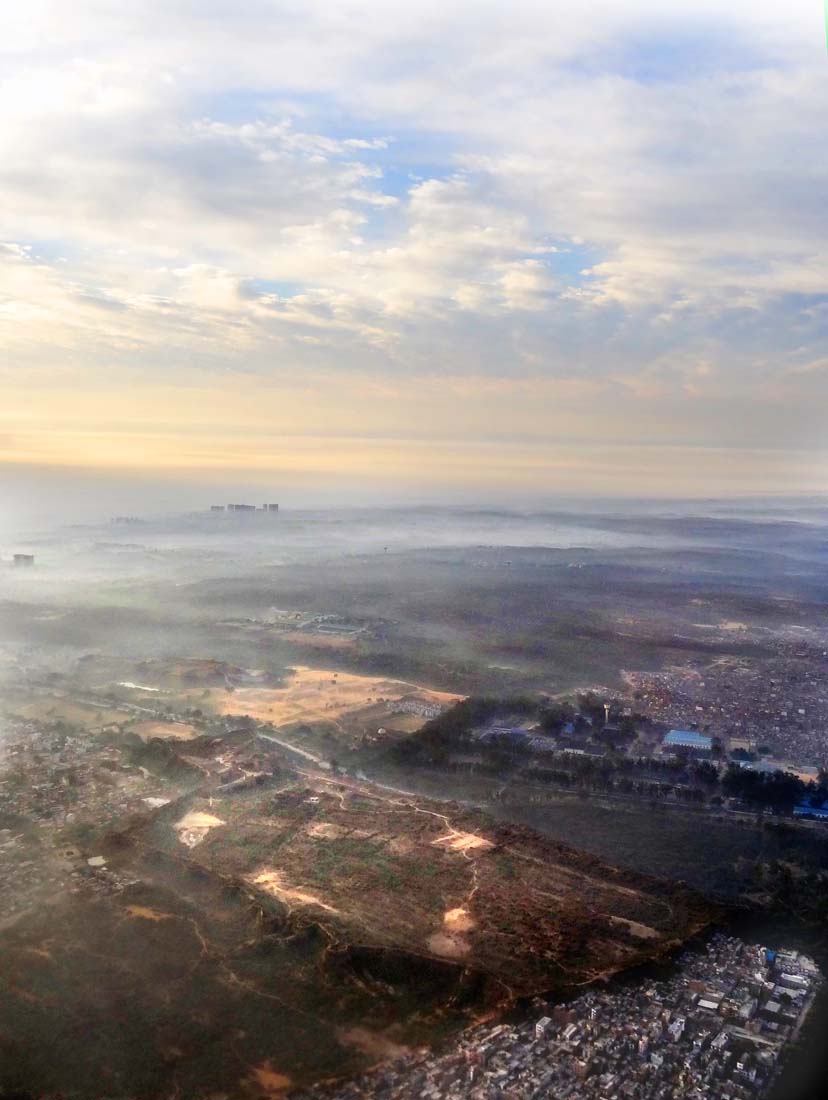
SO2 ‒ 30 ug / m3
NOx ‒ 75 ug / m3
RSPM ‒ 275 ug / m3
Blue Rock-Thrush
Monticola solitaria
Migrant
“This bird is a winter visitor occurring in small numbers. It haunts ruins almost exclusively. There were several Blue Rock-Thrushes in the ruin city of Tughlakabad, but in smaller ruins there would probably be only one. My records, which were very many, indicate that it reaches Delhi towards the end of October and leaves in April. In three successive years, 1943-1945, the bird was first seen on 31st October, 22nd October and 3rd November respectively: all of these occurrences were at Humayun's Tomb.” ‒ The Birds About Delhi, Page 28, The Delhi Bird Watching Society, 1954.
Developer's Paradise
May 2014

SO2 ‒ 15 ug / m3
NOx ‒ 45 ug / m3
RSPM ‒ 85 ug / m3
Pond Heron
Ardeola grayii
Resident
“Delhi's rapid and haphazardly planned 'development' could be affecting any of these areas [favorite spots for birds and birdwatchers in Delhi] even while this booklet goes to press – so don't blame us if you find one of the wetlands drained out and a housing colony coming up in its place! (But do write in and tell us about it).” ‒ What's that bird? A guide to birdwatching, with special reference to Delhi, Page 52, Kalpavriksh, 1991.
Qutab Minar
February 2012
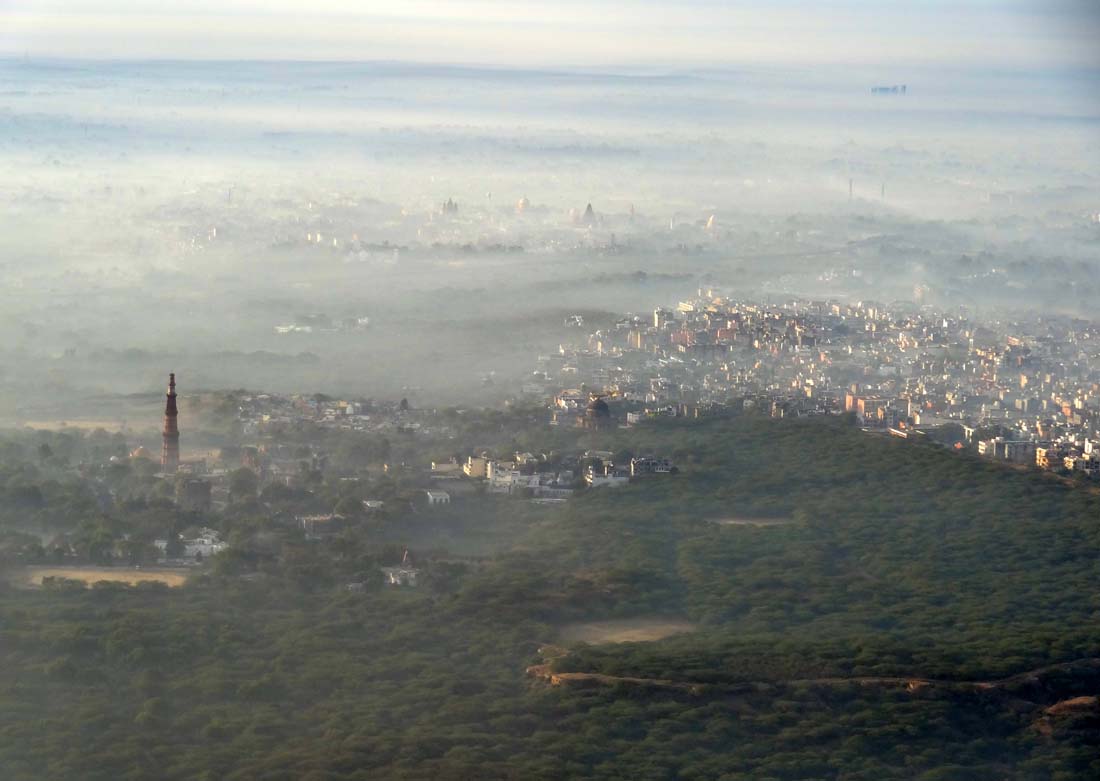
SO2 ‒ 30 ug / m3
NOx ‒ 75 ug / m3
RSPM ‒ 275 ug / m3
Shikra
Accipiter badius
Resident
“Also worth a visit are the rocky areas of Tughlaqabad and Mehrauli, in extreme south of Delhi. Both these are believed to be an extension of the Aravallis, and, where undisturbed by quarrying and construction, retain their original scrub character. Birdlife is similar to that in JNU, but much less explored – Tughlaqabad has the added attraction of an imposing fort, and Mehrauli of innumerable medieval buildings. Delhi's only sanctuary, the Indira Priyadarshini Sanctuary, is nearby. Though quite degraded, this area has the potential to develop into a good area for birds.” ‒ What's that bird? A guide to birdwatching, with special reference to Delhi, Page 52, Kalpavriksh, 1991.
Delhi Metro
February 2012

SO2 ‒ 30 ug / m3
NOx ‒ 75 ug / m3
RSPM ‒ 275 ug / m3
Wall Creeper
Tichodroma muraria
Migrant
“During the War one was seen on the walls of the Secretariat. In January 1951 one was present at the Qutab Minar for two or three weeks at least.” ‒ The Birds About Delhi, Page 17, The Delhi Bird Watching Society, 1954.
Imported Habitats
June 2012
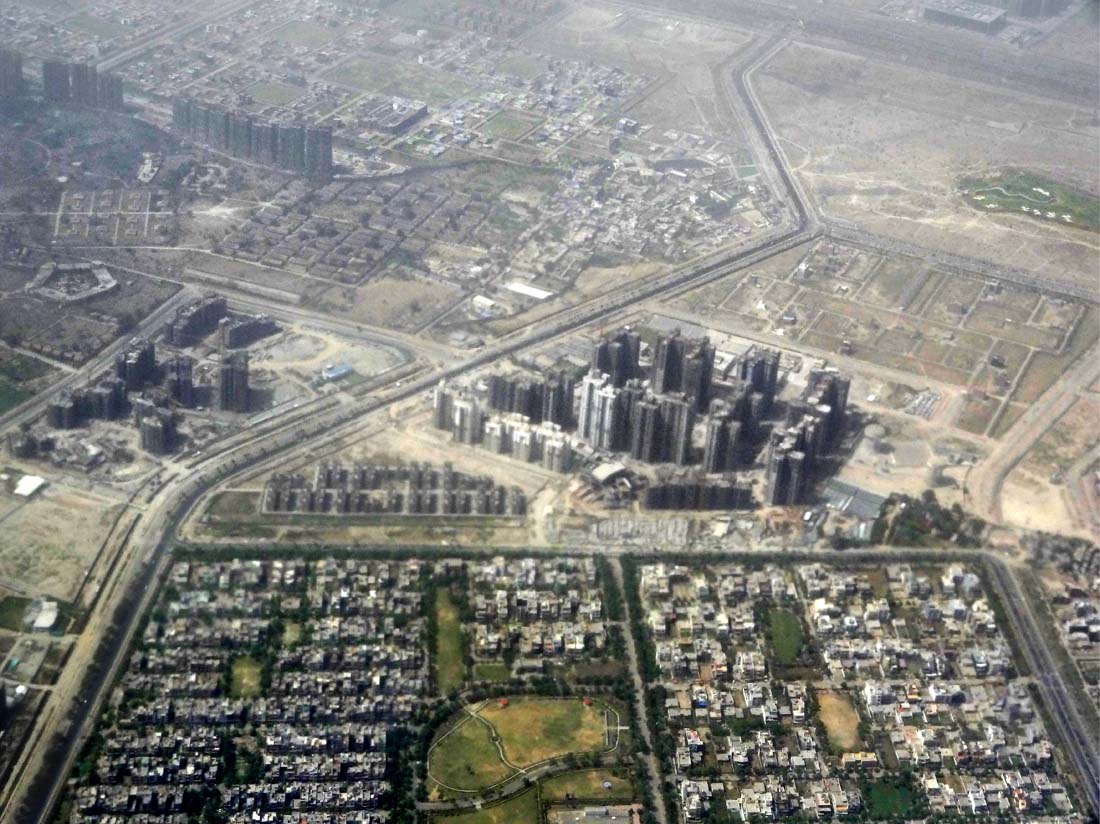
SO2 – 20 ug / m3
NOx – 50 ug / m3
RSPM – 80 ug / m3
Indian skimmer
Rynchops albicollis
Resident
“Delhi's – as all of India's – birds are today severely threatened by human activities. The gull-like Skimmer, its lower mandible (beak) wonderfully designed by Nature to skim the water's surface and catch fish swimming underneath, is probably already extinct in Delhi. How many more are on their way out is anybody's guess. Conservation of habitats is thus crucial today, and this can become possible only if informed people press for it.” What's that bird? A guide to birdwatching, with special reference to Delhi, Page 1, Kalpavriksh, 1991.
Contemporary Compounds
February 2012

SO2 ‒ 30 ug / m3
NOx ‒ 75 ug / m3
RSPM ‒ 275 ug / m3
Green bee-eaters
Merops orientalis
Resident
“An Indian compound is a splendid place for the beginner in bird-study, if it has a shrubbery, creepers on the house, and a few fairly dense trees like shisham, neem, or sirris. To list only those birds which I see all the year round, or frequently during their season, in a rather bare compound in Delhi: About the house, either on the verandah or lawn, or on the roof and chimneys; sparrows, robins, mynahs, wagtails, chats, hoopoes, doves, kites, vultures, crows; and, on the tops of the gate-posts in the twilight, Little Owls. In and about the shrubs, creepers, and hedges; bulbuls, red-starts, the Purple Honey-sucker, the Tailor Bird, several kinds of wrens and warblers, the 'sat bhai' (Jungle Babblers), and the Crow Pheasant and its ill-omened cousin the Brainfever Bird. In the trees or on the telegraph wires and posts; Blue Jays, King Crows, kites, shrikes, bee-eaters, swallows, tree-pies, orioles, parrots, hornbills, the Gold-backed Woodpecker, the White-fronted King-fisher and the big Horned Owl.” ‒ Indian Bird-Life, Page 14, Holmer, M.R.N., 1923.
Inconvenient Nests
May 2012

SO2 ‒ 15 ug / m3
NOx ‒ 40 ug / m3
RSPM ‒ 80 ug / m3
Grey hornbill
Tockus birostris
Resident
“For all birds, bringing up a family successfully is the most anxious business of the year, fraught with hazards and dangers which are of course increased when a long migratory journey precedes the nest-building. A nesting bird family is in an extremely vulnerable position and it needs every kind of help and protection from its environment. The birds need cover in which to hide the nest; they need building material; they need warm weather, first for the protection of their eggs and later their chicks; they need a plentiful supply of food for the chicks and lastly they need long daylight hours in which to search for the food. On the whole the most important item is the food supply. Birds will choose a nesting season when they can be sure of a liberal supply of food even if it is a little inconvenient in other ways.” ‒ Common Birds, Page 12, Ali, Salim and Futehally, Laeeq, 1967.
Victory Wa(i)lls
February 2012

SO2 ‒ 30 ug / m3
NOx ‒ 75 ug / m3
RSPM ‒ 275 ug / m3
Brahminy kite
Haliastur indus
Migrant
“It has a peculiar, rather wild, squeal; but it is not so noisy a bird as its more plebian relation, the pariah-kite. It is, as is well known, sacred to Vishnu; hence the name of Brahminy Kite given it by Europeans in India. The Mussulman name Rumubarik, or lucky face, arises from an idea that when two armies are about to engage, the appearance of one of these birds over either party prognosticates victory to that side.” ‒ The Birds of India, Page 103-104, Jerdon, T.C., 1864.










